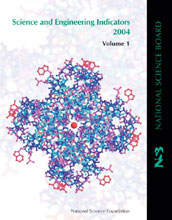|

Press Release 04-062
States Vary Widely on Indicators of Education, Workforce, R&D Spending and High-Tech Economies

S&E Indicators 2004 includes state-by-state breakdown of key statistics
May 4, 2004
ARLINGTON, Va.—Science and Engineering (S&E) Indicators 2004, a biennial report of the National Science Board to the president, presents for the first time a state-by-state breakdown of two dozen science and technology indicators. The information is designed to assist in analyzing state trends and developing state-wide goals.
The state statistics in S&E Indicators 2004, traditionally the nation's most authoritative source for national and international science and engineering trends, focus on secondary and higher education, the S&E workforce, research and development (R&D) spending, R&D outputs (such as doctoral degrees, patents and academic articles) and the high-tech economy.
The state chapter (Chapter 8) offers an easy-to-use resource, with a map for each indicator showing states in quartiles, a brief description of the indicator, key findings and a data table. A bar chart is included online. The state chapter can be accessed on the Web at www.nsf.gov/statistics/seind04/c8/c8.cfm.
As in past years, S&E Indicators 2004 Chapter 4 contains information on R&D expenditures by state. In 2000, the most recent year for which complete data were available, the 20 highest-ranking states continue to account for 87 percent of R&D expenditures, while the 20 lowest-ranking states account for only 4 percent.
The new state indicators permit comparisons that take into account a wider range of state characteristics. These measures demonstrate that R&D expenditures do not necessarily reflect a state's ranking on other indicators, such as eighth-grade educational performance, bachelor's degrees conferred, patents awarded, federal R&D spending or share of high-tech businesses.
State Indicator Highlights
- In most states, eighth-graders' mathematics performance on the National Assessment of Educational Progress improved from 1992 to 2000, and for those states with data available for 1996 and 2000, most showed a slight increase in eighth-graders’ science performance.
- A state's ranking in the workforce, R&D or economic indicators often does not reflect its standing in education indicators (eighth-grade math and science performance or bachelor's degrees conferred).
- College graduates are more likely to be found in states with strong federal and industry R&D investments or strong high-tech economies. The states with many bachelor's degree holders in the workforce are often not the same states conferring relatively high shares of those bachelor's degrees.
- A wide gap separates the top states for industrial R&D investment from those at the bottom. Similarly skewed distributions appear among rankings for federal R&D spending.
- States with a high proportion of high-tech businesses also show a higher percentage of bachelor's degree holders, S&E doctorate holders and S&E occupations in the workforce.
-NSF-

Media Contacts
David Hart, NSF (703) 292-7737 dhart@nsf.gov
Program Contacts
Rolf Lehming, NSF (703) 292-7810 rlehming@nsf.gov
Related Websites
S&E Indicators 2004: State Rankings for R&D: http://www.nsf.gov/news/news_summ.jsp?cntn_id=100682
Science and Engineering Indicators 2004: http://www.nsf.gov/statistics/seind04/
SEI2004 State Indicators: http://www.nsf.gov/statistics/seind04/c8/c8.cfm

The National Science Foundation (NSF) is an independent federal agency that supports fundamental research and education across all fields of science and engineering. In fiscal year (FY) 2009, its budget is $9.5 billion, which includes $3.0 billion provided through the American Recovery and Reinvestment Act. NSF funds reach all 50 states through grants to over 1,900 universities and institutions. Each year, NSF receives about 44,400 competitive requests for funding, and makes over 11,500 new funding awards. NSF also awards over $400 million in professional and service contracts yearly.
 Get News Updates by Email Get News Updates by Email
Useful NSF Web Sites:
NSF Home Page: http://www.nsf.gov
NSF News: http://www.nsf.gov/news/
For the News Media: http://www.nsf.gov/news/newsroom.jsp
Science and Engineering Statistics: http://www.nsf.gov/statistics/
Awards Searches: http://www.nsf.gov/awardsearch/
| 

